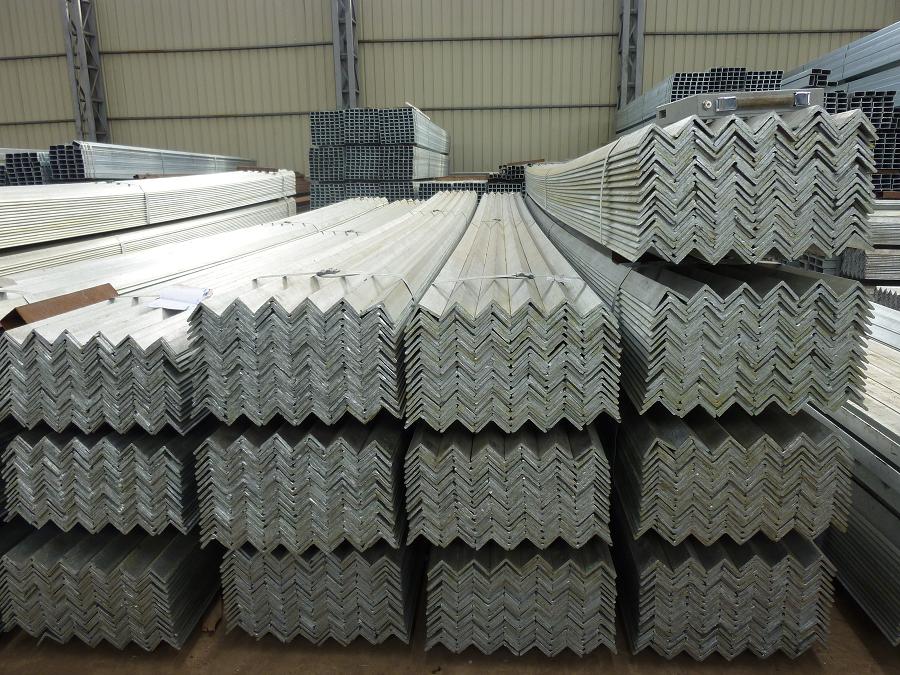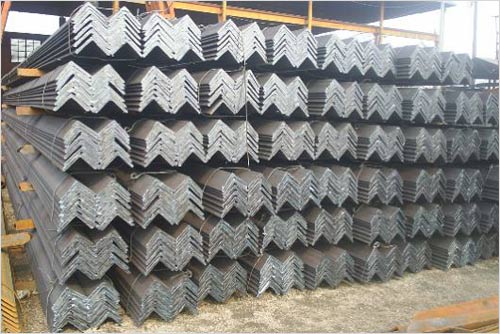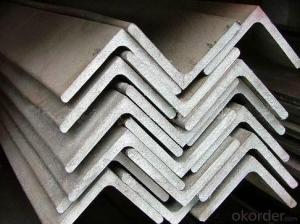S235 S355 SS400 A36 Q235 Q345 Construction Structural Hot Rolled Angle Iron or Equal Angle Steel
- Loading Port:
- Tianjin
- Payment Terms:
- TT OR LC
- Min Order Qty:
- 25 m.t.
- Supply Capability:
- 30000 m.t./month
OKorder Service Pledge
OKorder Financial Service
You Might Also Like
Packaging & Delivery
| Packaging Detail: | standard sea worhy package in bundles or at customer's request |
| Delivery Detail: | within 30 days after receive the deposit |
Specifications
Construction structural hot rolled Angle steel
size : 20*20 - 200*200 mm
Thickness : 3-20 mm
Material :S235 S355 SS400 A36
Construction structural hot rolled Angle steel
Product Description
Angle steel is commonly known as angle , its the long shape steel that both sides each other into vertical angle . Divided into equal angle and unequal angle .According to the stress of the structure of the different needs , angles can make into various components , also can make members between the joints widely used in various building structure , such as the beam , bridges , transmission , tower , lifting transportation machinery , ship , industrial furnace , reaction tower , container frame and warehouse .
Product Description
Angle steel is widely used in various building structure and engineering structure.
a.) beam, bridges, ship;
b.) transmission tower, reaction tower;
c.) lifting transportation machinery;
d.) industrial furnace;
e.) container frame, warehouse goods shelves, etc.
Standard | AISI, ASTM, BS, DIN, GB, JIS, etc mild angle steel |
Grade | Q235, Q345, SS400, A36, S235JR,S355JR, ST37-2,ST52, etc |
Equal Angle steel | Type: 2.5#-20# Size: 25-200mm Thickness: 3.0-20mm Weight: 0.597-71.168kg/m |
Unequal Angle steel | Type: 2.5/1.6-20/12.5 Long Side: 25-200mm Short Side: 16-125mm Thickness: 3.0-18mm Weight: 1.687-43.588kg/m |
Length | 5.8-12.0m OR according to client's request |
Element Contect | C<0.22% Si:<0.16% Mn: 0.30—0.65% P<0.060% S<0.060% |



- Q:What are the different grades of steel used in angle production?
- There are several different grades of steel that are commonly used in angle production. The specific grade of steel chosen depends on the intended application and the required strength and durability. Some of the most common grades of steel used in angle production include: 1. A36 steel: This is a low carbon steel that is commonly used in general construction and engineering applications. It offers good strength, weldability, and machinability, making it a versatile choice for angle production. 2. A572 steel: This is a high-strength, low-alloy steel that is often used in structural applications such as bridges, buildings, and heavy machinery. It provides excellent strength and toughness, making it suitable for angles that need to withstand heavy loads and extreme conditions. 3. A588 steel: This is a weathering steel that is designed to form a protective rust-like coating when exposed to the elements. It is commonly used in outdoor structures such as bridges, buildings, and sculptures. A588 steel angles are resistant to corrosion and offer good strength and durability. 4. A500 steel: This is a cold-formed, welded carbon steel that is often used in structural applications such as frames, supports, and braces. It is available in different grades, including A, B, and C, with varying strength levels. A500 steel angles are commonly used in construction projects where high strength and stability are required. 5. Stainless steel: This is a corrosion-resistant steel alloy that contains a minimum of 10.5% chromium. It is often used in applications that require resistance to corrosion, heat, and chemical exposure. Stainless steel angles are commonly used in industries such as food processing, chemical processing, and marine environments. These are just a few examples of the different grades of steel used in angle production. The selection of the appropriate grade depends on factors such as the intended application, desired strength and durability, and environmental conditions. It is important to consult with a steel expert or engineer to determine the most suitable grade of steel for a specific angle production project.
- Q:Are steel angles load-rated?
- Yes, steel angles are load-rated. The load rating of a steel angle depends on its dimensions, thickness, and material grade. The load rating is determined through engineering calculations and testing to ensure it can safely support specific loads and applications.
- Q:Can steel angles be used in telecommunications or broadcasting structures?
- Absolutely! Steel angles have a multitude of applications in the telecommunications and broadcasting industry. Their exceptional strength, durability, and versatility make them a staple in construction. From antenna mounts to equipment racks and cable trays, steel angles offer unparalleled structural support and stability. Moreover, their effortless fabrication and ability to be tailored to meet precise design specifications further solidify their suitability for a vast array of telecommunications and broadcasting needs.
- Q:Can steel angles be used for signposts?
- Yes, steel angles can be used for signposts. They are commonly used in construction and are known for their strength and durability, making them suitable for supporting signs.
- Q:What are the common lengths available for steel angles?
- The manufacturer and supplier determine the available lengths for steel angles, which can differ. Nevertheless, standard lengths are generally found in the market. These lengths usually span from 10 feet (3.048 meters) to 20 feet (6.096 meters). While some manufacturers may offer lengths that are longer or shorter depending on customer demands, the aforementioned lengths are commonly encountered in the industry. To ensure accurate information regarding the available lengths for steel angles, it is vital to consult the specific manufacturer or supplier, as they may offer various options tailored to different applications and customer requirements.
- Q:Are steel angles resistant to dynamic loads?
- Yes, steel angles are generally resistant to dynamic loads. Due to their structural properties and high strength-to-weight ratio, steel angles can effectively withstand dynamic forces such as vibrations, impacts, and other fluctuating loads without significant deformation or failure. However, the specific resistance to dynamic loads may vary depending on the size, grade, and design of the steel angle.
- Q:What is the maximum allowable bearing stress for a steel angle?
- The maximum bearing stress that a steel angle can withstand depends on several factors, including the type of steel, angle thickness and size, and specific application or design requirements. Generally, the maximum bearing stress is determined by assessing the angle's structural strength and stability under expected load conditions. To ascertain the maximum bearing stress for a steel angle, it is vital to refer to relevant industry standards, such as the specifications provided by the American Institute of Steel Construction (AISC) or the Eurocode design standards. These standards offer guidelines and formulas to calculate the maximum bearing stress based on the angle's properties and load factors. Moreover, factors like the presence of additional reinforcements, corrosion or surface imperfections, and the method of connection or support can also impact the maximum bearing stress. Hence, it is crucial to consult the appropriate design codes and seek advice from a structural engineer or steel design expert in order to accurately determine the maximum allowable bearing stress for a specific steel angle in a given application.
- Q:What are the different standards for steel angles?
- Steel angles, commonly used in construction and industrial applications, adhere to various standards to meet specific requirements. The American Society for Testing and Materials (ASTM) standard, specifically ASTM A36, is widely recognized and specifies the chemical composition, mechanical properties, and tolerances of steel angles. This standard is suitable for general structural purposes and is available in different sizes and lengths. Similarly, the European standard, known as EN 10025, encompasses multiple grades of steel angles, including S235, S275, and S355, which correspond to different yield strengths. These angles find extensive use in construction, machinery, and engineering industries throughout Europe. Country-specific standards also exist, such as the Japanese Industrial Standards (JIS) and the British Standards (BS). JIS G3101, a renowned standard in Japan, outlines the specifications for hot-rolled steel angles used in general structures. Meanwhile, BS EN 10056, a British standard, provides specifications for steel angles employed in construction. Furthermore, specialized standards cater to specific applications, such as marine-grade steel angles that withstand corrosion in saltwater environments. These standards, like ASTM A588, impose additional requirements for chemical composition and mechanical properties to ensure durability in harsh conditions. In conclusion, the diversity of steel angle standards guarantees that these structural shapes fulfill precise requirements regarding strength, durability, and compatibility with various construction and industrial applications. To ensure compliance with necessary specifications, it is crucial to consult the appropriate standard when selecting steel angles.
- Q:Can steel angles be used for manufacturing bike racks?
- Certainly! Bike racks can indeed be manufactured using steel angles. These angles offer both strength and durability, making them ideal for supporting the weight of numerous bicycles. Moreover, steel angles can be effortlessly welded or bolted together to construct a robust frame for the bike rack. The adaptability of steel angles enables customization and design flexibility, allowing for the accommodation of various bicycle types and sizes. Furthermore, steel angles possess the ability to withstand outdoor conditions and are resistant to rust and corrosion, ensuring the bike rack's longevity. In conclusion, steel angles are a dependable and pragmatic option for bike rack manufacturing.
- Q:Can steel angles be used for manufacturing ladders?
- Yes, steel angles can be used for manufacturing ladders. Steel angles are commonly used in ladder construction due to their strength and durability. They provide a sturdy framework and can withstand heavy loads, making them suitable for ladder applications. Steel angles also offer resistance to bending and twisting, ensuring stability and safety when climbing. Additionally, they can be easily welded or bolted together to create the desired ladder structure. Overall, steel angles are a reliable choice for manufacturing ladders.
1. Manufacturer Overview |
|
|---|---|
| Location | |
| Year Established | |
| Annual Output Value | |
| Main Markets | |
| Company Certifications | |
2. Manufacturer Certificates |
|
|---|---|
| a) Certification Name | |
| Range | |
| Reference | |
| Validity Period | |
3. Manufacturer Capability |
|
|---|---|
| a)Trade Capacity | |
| Nearest Port | |
| Export Percentage | |
| No.of Employees in Trade Department | |
| Language Spoken: | |
| b)Factory Information | |
| Factory Size: | |
| No. of Production Lines | |
| Contract Manufacturing | |
| Product Price Range | |
Send your message to us
S235 S355 SS400 A36 Q235 Q345 Construction Structural Hot Rolled Angle Iron or Equal Angle Steel
- Loading Port:
- Tianjin
- Payment Terms:
- TT OR LC
- Min Order Qty:
- 25 m.t.
- Supply Capability:
- 30000 m.t./month
OKorder Service Pledge
OKorder Financial Service
Similar products
New products
Hot products
Related keywords



























